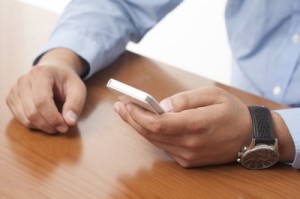Simple Ways to Secure Your Smartphone
- 10
- Mar

Image courtesy of patrisyu / FreeDigitalPhotos.net
No matter what business you’re in, an unsecured smartphone can lead to unintentional data leaks of personal and professional information. Whether it is family photos, sensitive company updates, client lists, or secret recipes, intruders no longer need to have physical access to your device in order to obtain this confidential information. In this article, we’ll review the simple steps you can take to ensure that your smartphone stays as secure as possible whether it is forgotten in a cab or tucked away in your briefcase.
Passcode Lock
Putting a passcode lock on a smartphone is the first step to fighting off unwanted visitors. Not only will it be the initial line of defense if a phone is lost, but it will also protect a phone that is seemingly left securely on a desk in the office while the user takes a bathroom break. Some devices even offer device-wipe capabilities so that if a passcode is entered incorrectly a specified number of times, the device will automatically erase all data on the phone.
Short Lock Time
Though it may be inconvenient to type in a passcode every time you want to access your device, putting a short lock time will make sure that your device seals up quickly before any unwanted hands can grab the device. Keep the lock-time to 1-2 minutes. (Bonus: This will also save battery life since it will shut off your phone’s screen.)
Smartphone Security
Just as PC’s have virus protection, certain mobile devices are more vulnerable to attacks and therefore may require additional security. In terms of smartphones, Android devices are the most vulnerable to infiltration due to their open-source operating system. In the right hands, this information can be used to create advancements. In the wrong hands, it can be used to discover security flaws to exploit.
Encryption
Every smartphone has different settings, different levels of security, and different capabilities. While it isn’t for everyone, encrypted backups and data transmissions may be a simple enough addition that performing the steps to secure your device can be a business- and/or life-saver. Blackberry has recently discussed their “NSA-proof” encryption, touting that while the government has been able to bypass security on Apple, Windows, and Android phones, they have been unable to crack Blackberry’s custom cryptography.
Download Updates
Operating system updates often contain bug fixes, efficiency advancements, and, most importantly, security patches. Ensuring that your device is updating regularly will help guard against unwanted intruders. In a recent case with Apple, one of their updates actually created a security flaw which was promptly fixed with a follow-up download. Checking for updates will ensure that you have the latest, most-secure version of your operating system as soon as it’s available.
Turn Off Auto-Connections
Whether it is Bluetooth or WiFi, automatically connecting to a network or device can leave a smartphone open to undesirable guests. While connecting automatically to secure home or work WiFi connections is a convenient way to save on data costs, some carriers offer their own free wireless hotspots which can automatically connect. Unfortunately, these hotspots are not always secure. Further, never authorize any Bluetooth device that you are not currently pairing with your smartphone. Pairing an unknown Bluetooth device can allow hackers access to all of your stored information.

Image courtesy of Salvatore Vuono / FreeDigitalPhotos.net
Trusted Apps Only
Many users will download applications from games and banking to fitness and password storage. It’s important to research applications to understand who created them and what their privacy policies are. Only download official apps created specifically by the brand as many third-party developers without authorization may have an alternate agenda. Always read the reviews of an application before downloading as this will provide quick information as to the validity of the program. Each application will have also access to a variety of information, so understanding the terms of use can be extremely beneficial when trying to protect your data.
Don’t Save Login Information
Many browsers will store login information to allow the user to more easily access his/her accounts on a specific website. While saving this data may reduce login time, it also means that a lost or stolen smartphone is providing that much more data to an intruder.
Be Wary of Links
Phishing links and downloadable viruses can come in the forms of emails and messages from friends. If you don’t know the number, it’s easier to decide the link may be harmful to your device. If it’s from a friend and it seems in any way suspicious (no accompanying explanation, unrecognizable website, etc.), it’s best to contact the person outside of that message and verify that they meant to send it. If the link is part of a scheme, the victim will be able to contact his or her address book to warn them not to trust the link.
Whether lost, stolen, or simply hacked into, smartphones contain a wealth of personal data. In the wrong hands, this can lead to identity theft, financial theft, and more. While no smartphone is 100% secure, taking the steps discussed above can ensure that any unwelcomed guests have a much more difficult time accessing your personal data.
If you have any questions about how to set up your device to be as secure as possible, please don’t hesitate to contact us.
